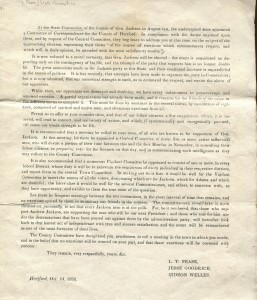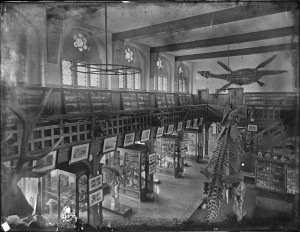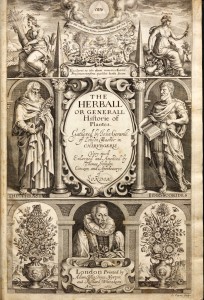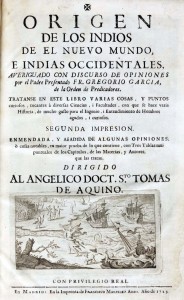 We are fortunate indeed to own a fabulous resource for the study of native Mexican culture, which came to my attention (as many things do) when a professor “discovered” we had it and asked to bring in a class to see it. Professor Chris Couch brought his American Studies (870) class on artistic and linguistic traditions of Native Americans (primarily North- and Central America) to look at this and other sources in the Watkinson.
We are fortunate indeed to own a fabulous resource for the study of native Mexican culture, which came to my attention (as many things do) when a professor “discovered” we had it and asked to bring in a class to see it. Professor Chris Couch brought his American Studies (870) class on artistic and linguistic traditions of Native Americans (primarily North- and Central America) to look at this and other sources in the Watkinson.
Antiquities of Mexico (London, 1831-1848, 9 volumes), compiled by Edward King, Viscount Kingsborough (1795-1837). Its publisher was Robert Havell (of Audubon fame).
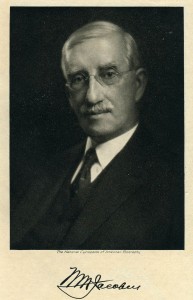 This copy was donated to the Watkinson Library in the spring of 1910 by the Rev. Dr. Melancthon Williams Jacobus (1855-1937), and his wife, Clara May, whom he married in Hartford in 1896. Jacobus was a Pennsylvania-born graduate of Princeton (class of 1877), who studied at the Princeton Theological Seminary (1878-81) and abroad at Gottingen and Berlin. In 1884 he became pastor of the Presbyterian Church in Oxford, PA until 1891, when he came to the Hartford Theological Seminary to take the position of Hosmer Professor of New Testament Exegesis and Criticism, retiring to emeritus in 1928. He was a Trustee of the Watkinson for 31 years, from 1906-37, was a generous donor of books and supplies, and served as Board President from 1924-35. In 1916 he was instrumental in founding the Kingswood academy (now Kingswood Oxford School) in West Hartford, donating 18 acres of land for the campus.
This copy was donated to the Watkinson Library in the spring of 1910 by the Rev. Dr. Melancthon Williams Jacobus (1855-1937), and his wife, Clara May, whom he married in Hartford in 1896. Jacobus was a Pennsylvania-born graduate of Princeton (class of 1877), who studied at the Princeton Theological Seminary (1878-81) and abroad at Gottingen and Berlin. In 1884 he became pastor of the Presbyterian Church in Oxford, PA until 1891, when he came to the Hartford Theological Seminary to take the position of Hosmer Professor of New Testament Exegesis and Criticism, retiring to emeritus in 1928. He was a Trustee of the Watkinson for 31 years, from 1906-37, was a generous donor of books and supplies, and served as Board President from 1924-35. In 1916 he was instrumental in founding the Kingswood academy (now Kingswood Oxford School) in West Hartford, donating 18 acres of land for the campus.
[The following is quoted in full from a London bookseller’s excellent description of a copy currently on the market]
The greatest illustrated work on Mexican antiquities. Supported by Sir Thomas Phillipps – many of whose manuscripts are described in the Antiquities – Edward King, Viscount Kingsborough (1795 – 1837), who first became fascinated by Mexican artifacts whilst studying at Oxford, employed the Italian painter Augustine Aglio to scour Europe’s greatest libraries and private collections for Mexican manuscripts. Aglio sketched and later lithographed these manuscripts for publication here in Kingsborough’s magnum opus. Although Kingsborough’s intention was to prove that the indigenous people of the Americas were a lost tribe of Israel, he inadvertently produced one of the most important books on the architecture and extant codices of Central America and Mexico ever produced. The cost of producing the work was enormous and Kingsborough reportedly spent more than £32,000, driving him into bankruptcy and debtor’s prison as well as litigation with Phillips. Kingsborough died of typhoid contracted while in prison for a debt to a paper manufacturer mere months before he inherited the estate, with an annual income of £40,000, of his father, the Duke of Kingston. This set is from the Havell issue: Aglio began publication of the first five volumes in 1830 but later, in 1831, transferred publication to Havell and Colnaghi who printed newer title pages. Besides Aglio’s reproductions of manuscripts in the Bodleian, the Vatican Library, the Imperial Library of Vienna, the Library of the Institute at Bologna, and the royal libraries of Berlin, Dresden, and Budapest, the work includes Dupaix’s ‘Monuments of New Spain’ (‘the first drawings of Maya architecture to be published’, Wauchope), taken from Castaneda’s original drawings, and descriptions of sculptures and artifacts from several private collections. The text, with sections in Spanish, English, French, and Italian, includes Sahagun’s ‘Historia General de la Nueva Espana’ and the chronicles of Tezozomoc and Ixtlilxochitl.
 The Watkinson has a great Bible collection, including this, the first separate edition of the Hebrew Bible printed in England, preceded only by the printing of the text as part of the Walton Polyglot (which we also have!). Editor Nathaniel Forster (1718–57), an accomplished scholar of Greek, Latin, and Hebrew, has included (in the style of the table of contents) “Pentateuchus, Prophetae priores, Prophetae posteriores, Hagiographa”; the leaves following “Prophetae posteriores” are separately signed and printed “Vol. 2.” Based on Van der Hoogh’s version, the text is in Hebrew, with titles and chapter heads also in Latin. Unlike most 18th-century books printed at Oxford, this is scarce. Of the eight reported copies in libraries four are in the Northeast, two in California, one at Duke, and one in Ohio.
The Watkinson has a great Bible collection, including this, the first separate edition of the Hebrew Bible printed in England, preceded only by the printing of the text as part of the Walton Polyglot (which we also have!). Editor Nathaniel Forster (1718–57), an accomplished scholar of Greek, Latin, and Hebrew, has included (in the style of the table of contents) “Pentateuchus, Prophetae priores, Prophetae posteriores, Hagiographa”; the leaves following “Prophetae posteriores” are separately signed and printed “Vol. 2.” Based on Van der Hoogh’s version, the text is in Hebrew, with titles and chapter heads also in Latin. Unlike most 18th-century books printed at Oxford, this is scarce. Of the eight reported copies in libraries four are in the Northeast, two in California, one at Duke, and one in Ohio.


